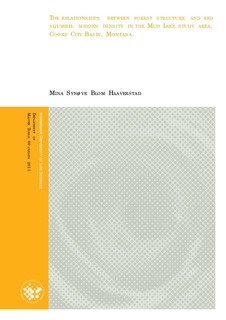| dc.description.abstract | Whitebark pine (Pinus albicaulis) seeds are a very important food source for grizzly bears (Ursus arctos horribilis) and other species in the Greater Yellowstone Ecosystem. Whitebark pine is a long-lived stone pine of high-elevation forests in southwestern Canada and the western United States, with large nutrition-rich seeds. The cones do not abscise or release their seeds in fall, so bears have to raid red squirrel (Tamiasciurus hudsonicus) middens; a large site on the forest floor where squirrels open gathered cones and hide seeds.
In fall 2009 I documented forest structure, midden density and bear sign density on four transect lines near Mud Lake, Cooke City Basin, south-central Montana. These transect lines were originally part of a larger bear study with 27 transect lines, where data on bear sign were collected between June-October in 1990-1991 and between July-October in 1996, 1997, 2003, 2004, and 2007-2009.
My predictions where; (i) a higher density of middens in mixed forest; (ii) a positive relationship between bear sign and midden density; and (iii) a high density of trees with beetle infection in the Mud Lake study area. I found that the density of red squirrel middens were highest in mixed forest with a high content of whitebark pine trees. Midden density, both number of separate middens and midden area, increased with more cone-producing trees. Red squirrels are dependent on other conifers when the highly variable whitebark pine cone crops are low. I also found more bear sign in association with high densities of red squirrel middens, which shows that whitebark pine is an important habitat for bears. The amounts of dying and newly dead trees I found in my study can infer a coming epidemic of mountain pine beetle and blister rust. This can have enormous consequences for the animals that are so dependent on the food supply that whitebark pine offers. Whitebark pine as a keystone species supports a wide range of different species and a decrease of whitebark pine trees most likely will lead to less biodiversity. | en_US |
